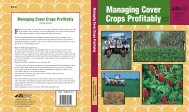Forms and Function of Essential Plant Nutrients - Valley Crops Home
Forms and Function of Essential Plant Nutrients - Valley Crops Home
Forms and Function of Essential Plant Nutrients - Valley Crops Home
Create successful ePaper yourself
Turn your PDF publications into a flip-book with our unique Google optimized e-Paper software.
<strong>Forms</strong><br />
Nitrogen fertilizer is available to the plant from several different sources, including<br />
fertilizers, manures <strong>and</strong> legumes. The amount <strong>of</strong> nitrogen from organic forms<br />
varies depending on the origin, how it was h<strong>and</strong>led <strong>and</strong> stored <strong>and</strong> the<br />
decomposition rate <strong>of</strong> the material. Common inorganic fertilizer forms <strong>of</strong> N<br />
available in Virginia include:<br />
- Ammonium nitrate (33-0-0)<br />
- Ammonium sulfate (21-0-0-24S)<br />
- Diammonium phosphate or DAP (18-46-0)<br />
- Urea (46-0-0)<br />
- Urea ammonium nitrate or UAN (liquid form containing 30% N by<br />
weight)<br />
Nitrogen Deficiency<br />
<strong>Plant</strong>s that are deficient in N typically show stunted growth <strong>and</strong> their foliage is<br />
pale green. Symptoms generally appear on the bottom leaves first, <strong>and</strong> lower<br />
leaves will sometimes have a “fired” appearance on the tips, turn brown <strong>and</strong> fall<br />
<strong>of</strong>f. In crops such as vegetables, forage <strong>and</strong> pasture, low N results in low yield<br />
<strong>and</strong> quality. With grain crops, such as corn <strong>and</strong> small grains, deficiency results in<br />
yellow leaf tips, stunted growth with spindly stalks <strong>and</strong> low yields <strong>of</strong> poor quality<br />
grain. Too much N causes excessive vegetative growth, delays maturity,<br />
increases lodging risk <strong>and</strong> promotes plant diseases.<br />
Phosphorus<br />
<strong>Function</strong><br />
<strong>Plant</strong> growth will not occur without phosphorus (P). Concentration <strong>of</strong> P in most<br />
plants is between 0.1 <strong>and</strong> 0.4%, lower than either N or potassium. <strong>Plant</strong>s absorb<br />
P either as H 2 PO 4 - or HPO 4 2- orthophosphate ions, depending on the pH. <strong>Plant</strong>s<br />
may also absorb organic phosphate forms, made available as soil organic matter<br />
is decomposed. The most essential function <strong>of</strong> P in plants is in energy storage<br />
<strong>and</strong> transfer. Nucleic acids, phospholipids, coenzymes DNA <strong>and</strong> NADP, <strong>and</strong><br />
most importantly ATP rely on P for the energy required to function. ATP is the<br />
source <strong>of</strong> energy that powers practically every energy-requiring biological<br />
process in plants. Phosphorus is also required for other essential metabolic<br />
processes, such as photosynthesis, glycolysis, respiration, <strong>and</strong> fatty acid<br />
synthesis.<br />
Phosphorus:<br />
1. Enhances seed germination <strong>and</strong> early growth<br />
2. Is associated with increased root growth<br />
3. Stimulates blooming <strong>and</strong> bud set<br />
4. Improves straw strength<br />
5. Increases disease resistance<br />
6. Aids in seed formation<br />
7. Hastens plant maturity<br />
8. Provides winter hardiness<br />
2
















